|
|
Newsletter June 2021 | Menu of Newsletters

BioOptics Vibration
Isolation | A Tool for Brain Discovery
The ability to measure micron-level
neuronal activity patterns in the mammalian neocortex is enabling insight into
brain sensory and motor processing functions related to cardiac fibrillation
and epilepsy. Voltage-sensitive dye, optical recording techniques, and
vibration isolation are key to the work.
"At first, we used high-quality air
tables, but they were not adequate for isolating low frequency vibrations," but
then settled upon
negative-stiffness mechanism systems from
Minus K Technology. |
By Jim McMahon
(Legacy
Article) Professor Jian-Young Wu has been conducting research on waves of
neuronal activity in the neocortex of the brain. Wu and his colleagues at the
Department of Physiology and Biophysics at Georgetown University Medical Center
visualize wave-like patterns in the brain cortex using optical imaging and
voltage-sensitive dyea method that depends on robust vibration isolation. Their
neuronal specimens are derived from slices of rat neocortex, the outer layer of
a mammal's brain, which is involved in higher functions such as sensory
perception and generation of motor commands and, in humans, language.
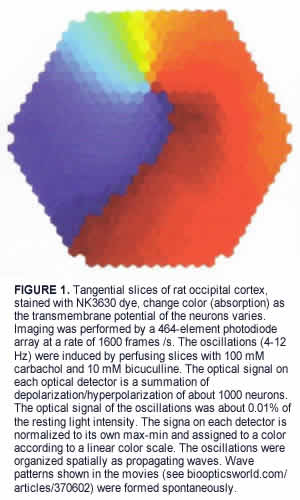
The neurons of the neocortex are arranged
in vertical structures called neocortical columns that measure about 0.5 mm in
diameter and 2 mm in depth. Each column typically responds to a sensory
stimulus representing a certain body part, or region of sound or
vision.
In the human neocortex, it is postulated that there are about a
half-million of these columns, each of which contains approximately 60,000
neurons.
The neocortex can be viewed as a huge web, consisting of
billions to trillions of neurons and hundred of trillions of interconnections.
While individual neurons are too simple to have intelligence, the collective
behavior of the billions of interneuronal interactions occurring each second
can be highly intelligent.
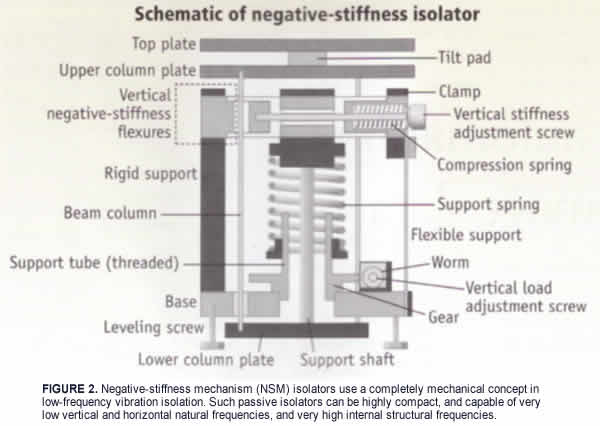
Full article... |

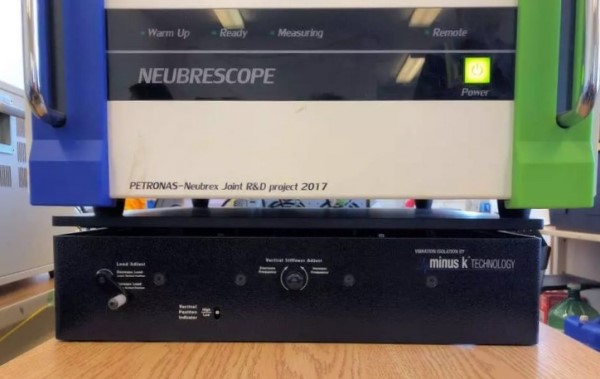
Negative-stiffness
Minus K BM-8 vibration isolator beneath the
Neubrescope.
By Jim McMahon
The latest
generation of fiber optic sensing systems employed to monitor well conditions
can augment operational performance in the oil & gas industry. Critical
data about the downhole well environment from distributed fiber optic sensing
(DFOS) systems improves engineers and scientists ability to arrive at decisions
that support operational optimization. This leads to well production
performance enhancement and safety at the well site, with the ultimate goal of
optimizing production from oil and gas wells. There is no other current method
to acquire the quality and level of detail about physical conditions in a
wellbore compared to fiber optics.
Distributed acoustic sensing (DAS) is
mainly used to listen to hydraulic fracturing related signals, fluid and gas
flow signals, or to sense seismic source response, such as in a vertical
seismic profile (VSP). DAS senses changes in small physical acoustic vibrations
along a glass fiber optic strand encased in a cable to measure vibrations.
There are thousands of detection points along the fiber in the subsurface fiber
optic cable.
DFOS is a technology that enables continuous, real-time
measurements along the entire length of a fiber optic cable at minimal spatial
intervals. Unlike conventional sensor systems that rely on discrete sensors
measuring at pre-determined points, distributed sensing does not rely upon
manufactured, discrete sensors, but uses the optical fiber itself as both
sensing device and two-way transmitter of the signal (light). Optical fiber is
the sensing element. without any additional transducers in the optical path.
Surface instruments called interrogator units (IU) send a series of laser light
pulses into the fiber and records the return of the naturally occurring
back-scattered light signal as a function of time. In doing this, the
distributed sensing system measures at all points along the fiber which are at
a pre-determined clock-time interval over periods of well operational
time
Because fiber optic cable can be installed in harsh environments
for long periods of time, the technology holds promise for environmental
monitoring of sensitive geologic operations. Many geofluid systems require
dynamic acoustic, temperature, strain and pressure monitoring at great
pressure, depth and temperature. Sensors that employ fiber optic cables serve
well for such deployments because they can withstand adverse environments.
Downhole application includes oil and gas wells (hydraulic fracture completion
operations, flow-back operations, long-term well monitoring, and well-integrity
monitoring), geothermal wells, deep industrial waste disposal wells and other
harsh environment applications.
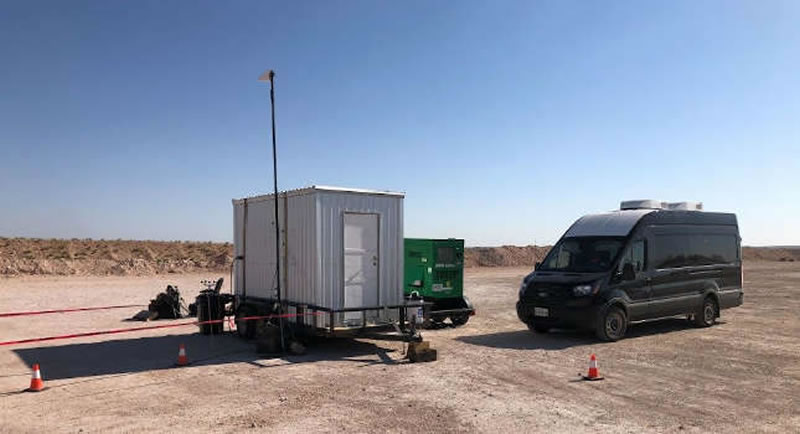 Neubrescope set up on site near well
operations. Neubrescope set up on site near well
operations.
Full article... |

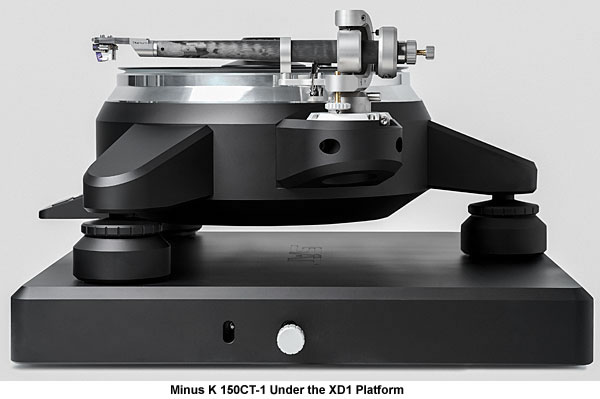
By Michael Fremer, Insider views on
everything vinyl
Let's begin by discussing what SAT's XD1 Record
Player System is not: It is not a Technics SP-10R in a sci-fiinspired
plinthalthough the XD1's engine does begin life as the SP-10R's basic drive
system, which is stripped down to a handful of essential components,
reimagined, reengineered, and rebuilt to much higher mechanical
standards..
Marc Gomez, SAT's designer, holds a master's degree in
mechanical engineering and materials science. Before dedicating himself to
creating the SAT tonearmby far the finest sounding and performing arm I've yet
encountered (as unanimously corroborated by Stereophile readers who bought this
very expensive product unheard as a result of my review)he was involved in a
variety of projects for, among others, the European Space Agency and various
European automobile manufacturers.
Even if it's not broken, why not
fix it?
The XD1 is a compact disc player, though not a player of compact
discs (footnote 1).
Its sculpted, satiny beauty goes beyond skin deep.
The XD1's metalwork, and that of the SAT tonearms, is machined at a Swedish
workshop that makes parts for Hasselblad cameras.
Gomez says that in
designing the XD1, he focused on four main areas: isolation from external
disturbances, speed stability, rigidity, and vacuum hold-down.
When Mr.
Gomez began conceptualizing his design a decade ago, it was immediately clear
to him, he says, that direct drive was the best way to spin a platter. His
reasons were these: A direct-drive motor's rotational speed is just 33.3, 45,
or 78rpm compared to several hundred rpm's required in the typical belt-drive
design, and with direct drive the spindle is not laterally loaded as it is in
belt-drive designs, so it receives only torque, not an off-center force. The
amount of torque available means the 'table is less likely to drag during
heavily modulated passages, something direct-drive advocates claim happens with
most belt designs.
Gomez says the drive-unit is no an off-the-shelf
motor designed for generic industrial applications. Rather, it is conceived and
built from the ground up to drive the XD1 (except for those few elements he
kept from the SP-10R motor, footnote 2). He says it's better balanced than the
motors typically used on belt-drive and idler turntables.
These claims
are hardly novel: If your old Technics SL-1200, which also uses a direct-drive
motor, could talk, it would make the same claims. Nor did Gomez address the
oft-cited disadvantages of direct-drive systems, which include motor "cogging"
(torque ripple), noise, and "hunting and pecking" as the quartz-locked system
readjusts to maintain speed consistency, a sort of analog "jitter" that
belt-drive advocates claim is sonically more pernicious than the slow, gradual
speed shifts a belt-drive table is more likely to experience.
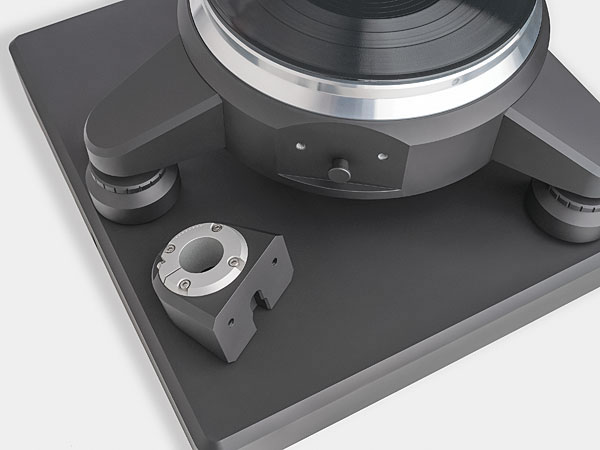
Full article (with footnotes)...
|

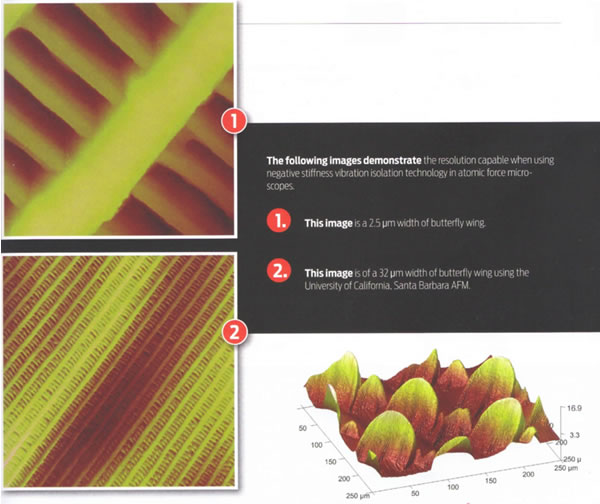
Here is an image of 250 µm width
of butterfly wing using University of California, Santa Barbara AFM with
negative-stiffness
vibration isolation.
(Lagacy 2013 article) With its
development in 1986, and subsequent commercial introduction in 1989, the
atomic force microscope
(AFM) is one of the foremost tools for imaging and measuring
materials and cells on the nanoscale. Revealing sample details at the atomic
level, with resolution on the order of fractions of a nanometer, the AFM is
instrumental for imaging an array of applications, such as defining surface
characterizations, lithography, datastorage, and manipulation of atoms and
nano-sized structures on a variety of surfaces.
The need for more
precise vibration isolation with AFM, though, is becoming critical as
resolutions continue to bridge from micro to nano.
AFM
systems are extremely susceptible to vibrations from the environment. When
measuring a very few angstroms or nanometers of displacement, an absolutely
stable surface must be established for the instrument. Any vibration coupled
into the mechanical structure of the instrument will cause vertical and
horizontal noise and bring about a reduction in the ability to measure with the
highest resolution.
The vertical axis is the most sensitive for AFMs,
but these microscopes are also quite sensitive to vibrations in the X and Y
axes.
The atomic force microscope uses a sharp tip (probe), with a
radius of curvature on the order of nanometers attached to the end of a tiny
cantilever used to scan across a sample surface to image its topography and
material properties. When the tip is brought into proximity of a sample
surface, forces between the tip and the surface lead to a deflection of the
cantilever This deflection is typically recorded using a laser beam that is
reflected from the top surface of the cantilever to a photosensitive detector.
The resultant position change of the cantilever allows characteristics such as
mechanical, electrostatic, magnetic, chemical and other forces to be precisely
measured by the AFM. These characteristics are displayed in a three-dimensional
surface profile of the sample (in the X, Y and Z axes)an advantage that the AFM
can provide compared to other microscopy techniques, such as the scanning
electron microscope (SEM) which delivers a two-dimensional image of a sample
(in the X and Y axes).
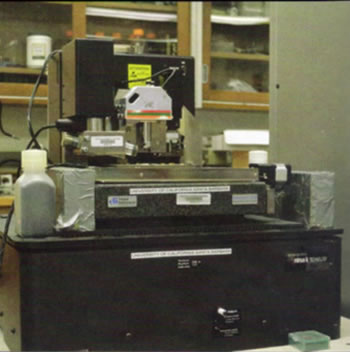
Minus K BM-1
Isolator.
Full article...
|

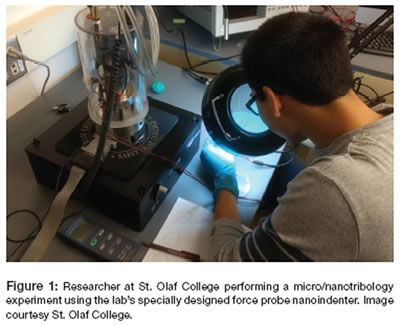
Abstract: Researchers in the Physics
Department of St. Olaf College are using a uniquely designed, integrated
nanoindenter-quartz microbalance apparatus to bridge the gap between the
fundamental science of friction and the engineering of practical
micromechanical systems. This level of micro-research requires extreme
stability for the microbalance instrumentation. Since 2001, the lab has used
negative-stiffness vibration isolation to achieve a high level of isolation in
multiple directions, custom tailoring resonant frequencies to 0.5 Hz vertically
and horizontally.
Introduction: Scientists do not fully
understand what causes friction and wear between two surfaces at the molecular
level. When designing a micromechanical system, the fundamental machine parts
of gears, hinges, pistons, gimbals, and suspended beams that flex are included.
Basic motions that are the essence of mechanics rely on these materials having
durability and low or controllable friction. Mastering these forces that occur
on small-scale surfaces of micromachines is a considerable challenge. When the
mechanical parts are very small, their properties are dominated by minute
surface forces that macroscopic machines are not sensitive enough to detect.
This raises entirely new questions about how to maintain minute components and
to keep them moving and protected from wear or breakage.
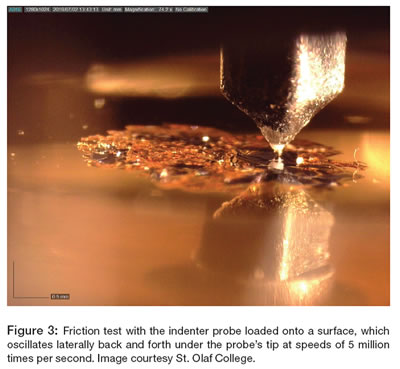
Silicon
Uniformity:
Engineers have relied on extremely thin lubricant films to
reduce friction and to keep parts moving inside tiny silicon-constructed
microelectromechanical systems (MEMS). But these films have not been
sufficiently effective in micromachines, which rely on relatively fast-moving
parts that are in contact with each other, such as gears, gimbals, and pistons.
Since the early 1980s, with the introduction of the first micromechanical
machines, the vision has been to batch-fabricate these devices as silicon chips
to link with circuitry that can be connected wirelessly. However, these small
silicon machines often disintegrate after just a few hours of operation. This
technology has, for some time, been struggling to make it to the marketplace.
Decades of research in both academia and business has been undertaken to
understand friction and wear well enough at these micro- and nano-scales to
effectively lubricate and provide wear protection.
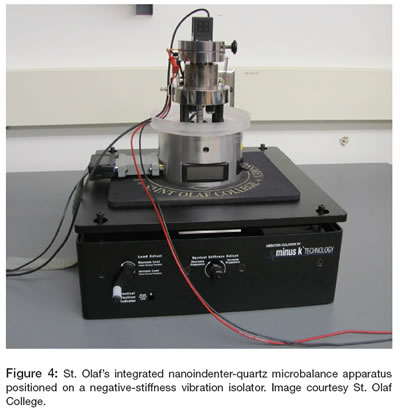
New Research
Methodology:
Professor Brian Borovsky, Associate Professor in the
Physics Department at St. Olaf College in Northfield, MN, has been researching
micro/nanotribology for over two decades [14]. He has pioneered friction
research as applied to very tiny micromechanical machines, having developed
state-of-the-art instrumentation and a process that tests frictional properties
of surfaces coated with ultrathin lubricants. His is one of the few labs that
can measure friction of micromachine surfaces sliding past each other at very
high speeds that approach 1m/s.
While equipped with scanning electron
(SEM) and atomic force microscopy (AFM) for analysis of surfaces, the labs
focus instrumentation is a specially designed force probe nanoindenter in
conjunction with a quartz microbalance...
Full article...
|
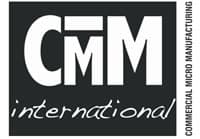
Commercial Micro Manufacturing -
Dec.2020
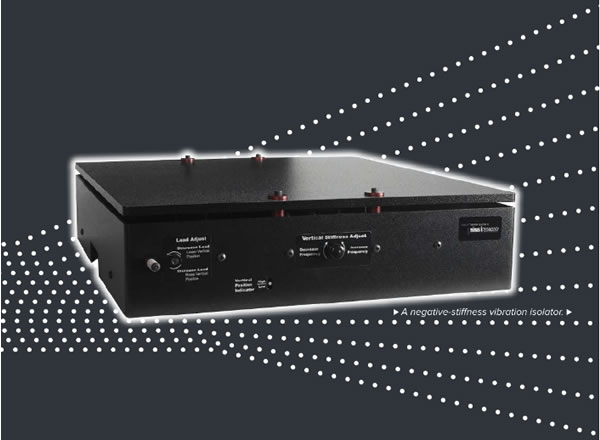
The need for nano- precision has became
increasingly important in many fields of research and manufacturing, inducing
microelectromcs fabrication, laser/optical system applications and biological
research. This has meant that so too has the need for vibration Isolation
technology that better facilitates the operation of sensitive Instrumentation
such as
atomic force microscopes, scanning tunneling
microscopes,
laser interferometers and optical
profilers.
Once the mainstay for stabilizing academia's
and Industry's most critical microenginering instrumentation, pneumatic (gas or
air pressurized) vibration Isolation tables are today proving unsatisfactory in
isolating disruptive
low-frequency vibrations. There is a growing trend
for locating sensitive instrumentation in building to locations that are
subject to extremely high levels of vibration and this is a significant
stumbling block for pneumatic vibration isolation tables, meaning alternative
vibration isolation solutions are required.
Vibration
sources
Nano-level instrumentation is sensitive to extremely small
payload vibrations that can be caused by a multitude of factors. Every
structure (building) transmits vibrations from Internal and external sources In
a building, heating and ventilation systems, fans, pumps and elevators are Just
some of the mechanical devices that create vibrations. Outside a building,
adjacent road traffic, nearby construction, aircraft and even wand and other
weather conditions all create vibrations How strongly the instrumentation is
influenced depends on where it is in the building and how far away it is from
the vibration sources.
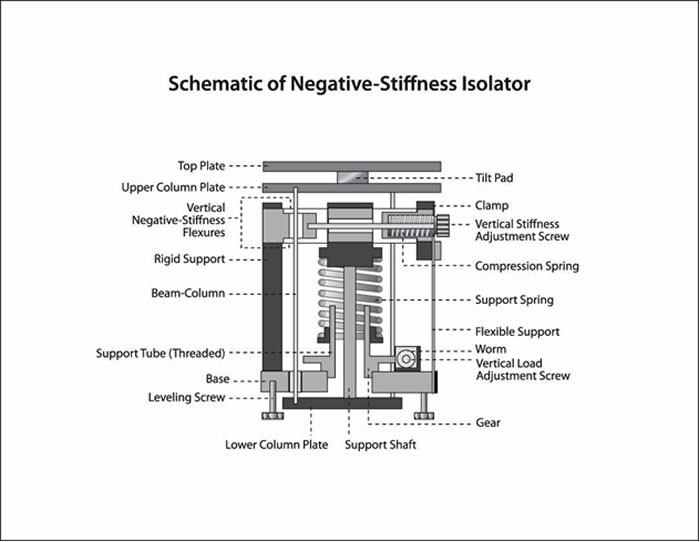
Isolation for vibration
critical applications
Over the past 25 years, two technologies have
gained prominence for their ability to Isolate vibrations Influencing
nano-level Instrumentation, namely active vibration isolation (also known as
electronic-force cancellation) and negative-stiffness vibration isolation {also
known as passive vibration isolation).
Both active and
negative-stiffness vibration isolation are uniquely equipped for applications
where structures smaller than a micrometre need to be produced or measured.
These technologies provide functionality that is typically not achievable with
pneumatic vibration isolation tables.

Full article: Comparing systems...
|
|
Press Release:
New Ultra-Thin
CT-2 Low-Frequency Vibration
Isolation Platform Adapts
to Space Constraints in Critical Micro- and
Nano-Microscopy
(replaces the CT-1)
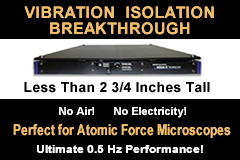

Full
release... |
 |

You might have thought, maybe for only a
few moments, that your
audio system was
sounding especially good. With that feeling, you would have rated the sound a
top score of "10". Then those magical moments ended and your system returned to
it's normal - but still good - performance level. Well, folks, the Minus K
CT-2 Isolation
Platform could raise your system score to an "11" and keep it there! Highly
recommended for systems that are already high performance and where you want to
coax the maximum performance from your audio investment....
Dr. David L.
Platus is President and Founder and is the principal inventor of the
technology. He earned a B.S. and a Ph.D. in Engineering from UCLA, and a
diploma from the Oak Ridge School of (Nuclear) Reactor Technology. Prior to
founding Minus K® Technology he worked in the nuclear, aerospace and
defence industries conducting and directing analysis and design projects in
structural-mechanical systems. He became an independent consultant in 1988. Dr.
Platus holds over 20 patents related to shock and vibration
isolation.

Ultra-Thin 2.7" High
CT-2 Product
Attributes:
- Isolation performance is typically 10 to 100 times
better than air systems
- No air or electric power is
required
- Nothing to wear out
- No
maintenance
A complete description of the
patented
Negative-stiffness design can be found on the
Technology page of the manufacturers Web site. The Minus K platform is
completely silent and requires no pumps or power. The
CT-2 model platforms
are available for different weight ranges of payload, or supported weight. The
40CT-2 model, while not specifically listed on the Web page, was perfect for
the Clearaudio Ovation
turntable used for
this review. The platform dimensions are 18" W x 20" D x 2.7" H, with a weight
of about 30 pounds. Different models, for different payloads, range in price
from $4,650 to about $5,250. In my system, the platform was installed 20" W x
18" D, which placed the adjustment crank on the 18" left side.
The
horizontal frequency of ~1.5 Hz is achieved at or near the upper limits of the
payload range. The vertical frequency is tunable to 0.5 Hz throughout the
payload range. What this means is that any very low frequency vibrations that
are not blocked or absorbed by the Minus K platform are several orders of
magnitude below what your phono cartridge, or even the best subwoofers, can
process.
Full article...
|

3D Surface Analysis Vibration
Isolation
High-precision, nanometer-level 3D surface
measurement systems can be negatively affected by low-frequency
vibration—distorting imaging and producing inaccurate measurement
readings. |
Manufacturers need to control processes to
produce a consistent, reliable product. Where precision surface engineering is
required, surface measurement may be a key part of maintaining control of the
process, by checking output to see that the process is not outside of
specification.
3D non-contact surface analysis is widely used in the
industry for the measurement of small displacements and surface irregularities.
It delivers the ultimate in high accuracy and repeatable and traceable
measurement. When built into microscopy equipment, employing 3D laser scanning
or structured light, these systems report the surface condition of a product
with more accuracy than any other methodproviding nanometer-level profile
measurements of height, width, angle, radius, volume, and roughness. Such
precision measurement systems allow users to improve product quality and
reliability, and increase manufacturing consistency and production
yields.
Low-Frequency Vibration
When measuring at such high
levels of precision, any instrument can be negatively affected by low-frequency
vibrations generated within a manufacturing facility. These can distort
measurements and impact imaging and measurement data
One company that
has great familiarity with the manufacturing environment and 3D surface
measurements is Keyence Corporation--a leading supplier of sensors, measuring
systems, laser markers, microscopes, and machine vision systems
worldwide.
We have many customers with high-precision 3D measurement
systems operating in high-vibration environments, performing microscopy
evaluation at 30,000 times magnification, looking at nanometer-level surface
features, said Evan Eltinge, Senior Sales Engineer Surface Analysis Team, with
Keyence Corporation of America. At that level of detail, and in that
environment, if measures are taken to reduce vibration it improves the quality
of the data.
Without proper isolation surface measurements occurring at
3,000 to 5,000 times magnification, the vibration could contribute to image
blurring and loss of image quality, continued Eltinge.
Vibration can be
caused by a multitude of factors within a plant; every structure is
transmitting noise. Within the building itself, production machinery, forklift
trucks, the heating and ventilation system, fans, pumps, compressors, and
elevators are just some of the mechanical devices and equipment that create
low-frequency vibration. Depending on how far away the surface measurement
instrumentation is from these vibration sources, and where inside the structure
the instrumentation is locatedwhether on the production floor or in a loftwill
determine how strongly the instrumentation will be influenced.
External
to the building, the equipment can be influenced by vibrations from truck
movement, road traffic, nearby construction, loud noise from aircraft, and even
wind and other weather conditions that can cause movement of the
structure.
Vibration Isolation Options for 3D Surface
Analysis...
Full article...
|
|
|
|

 |
|
|
